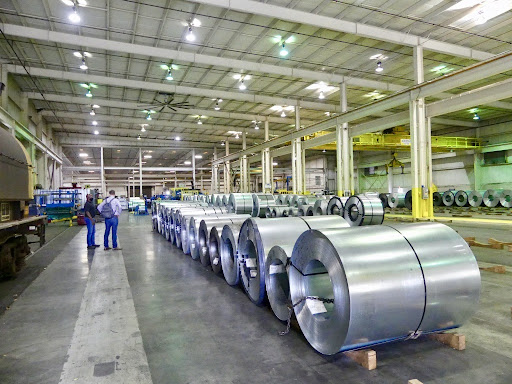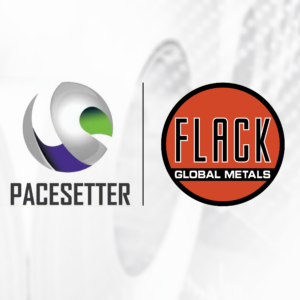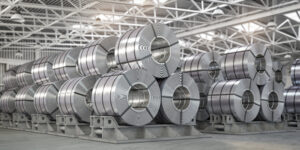Stainless Steel Products: What Do I Need to Know?
When it comes to a metal with strength and resistance to corrosion, stainless steel has been the standard for a long time. One of the amazing things about steel is all of the forms and qualities it can take on. Of these, stainless steel is incredibly popular due to its corrosion resistance combined with its strength and formability.
It’s a versatile alloy, and manufacturers can form stainless steel into sheets, plates, bars, wiring, and tubing. You’ll find stainless steel as a construction metal in large buildings, storage tanks for food production, cookware, surgical instruments, and even jewelry.
We are a trusted national steel supplier and manufacturer of stainless steel. We prepaint, perforate, emboss, or fabricate your stainless steel to meet your project requirements. In addition, we can provide comprehensive steel processing services, including slitting, blanking, toll processing, or cut-to-length, so your stainless steel is ready to use for your next job. Learn everything you need to know about this type of steel and contact us for a quote for your next project!
What is Stainless Steel?
Stainless steel is a combination of different base metals, usually carbon, chromium, or nickel. It is a low-carbon steel that contains chromium at 10.5% or more by weight. This chromium addition gives stainless steel its corrosion-resistant properties. Chromium contents also allow the formation of the steel’s stainless film, a rough adherent oxide. Provided oxygen is present, this film is self-healing, adding additional value to stainless steel products.
Stainless steel is named for the simple fact that it does not stain, corrode or rust like ordinary steel thanks to its protective film.
Other elements, including nickel and molybdenum, may be added to produce stainless steel, but chromium’s inclusion is the defining factor. With 60 grades of stainless steel and five major groups, the grade of stainless steel to specify depends on the type of environment the alloy must endure and the inclusion and quantities of other elements in the material.
Flat-rolled stainless steel can be finished in various ways according to our customers’ aesthetic and functional needs, from mirror finishes to brushed, coarse, or heat-colored finishes.
Other types of stainless steel exist and are helpful in various applications. There are thousands of varieties of stainless steel, but the most common categorizations include:
- Austenitic stainless steel is one of the most common types of stainless steel alloys. With high chromium content, austenitic stainless is extremely corrosion resistant and non-magnetic.
- Ferritic stainless steel tends to have a lower nickel content, which helps make this type of stainless cost less. It’s hardened through cold forming, is usually magnetic, and is the second most common type of stainless steel alloy.
- Martensitic stainless steel is the least commonly used type of stainless steel alloy. Usually combined with a protective polymer coating, it’s best in applications where high tensile strength and impact resistance is needed.
What is Stainless Steel Made Of?
Stainless steel is an alloy that can be made of many different metals. The most common metals are chromium, nickel, molybdenum, silicon, aluminum, and carbon. Each metal gives the resulting stainless steel specific properties.
For example, chromium helps with rust resistance, nickel enhances corrosion resistance, and copper or titanium can improve the structure. However, not all stainless steel uses all of these metals. We can customize your stainless steel to provide you with the exact metal you need for your project demands.
When Was Stainless Steel Invented?
Several corrosion-resistant iron artifacts have survived, indicating that similar metals were developed as early as 400 AD. In these artifacts, however, it was not chromium but phosphorus used to improve durability and allow objects like the Iron Pillar of Delhi to weather the test of time.
The corrosion-resistant quality of chromium in steel was first noted by the French metallurgist Pierre Berthier in 1821, but the products of the time were too brittle to be used practically. The credit for stainless steel’s invention typically goes to Harry Brearley of Sheffield in the United Kingdom in 1912. An expert steel analyst and researcher, Brearley developed stainless steel to assist a small arms manufacturer, then later applied this solution to cutlery.
Around the same time, similar industrial developments were taking place in Germany at Krupp Iron Works and in the United States by Christian Dantsizen and Frederick Becket.
Is Stainless Steel a Pure Substance?
The definition of a pure substance is that the substance only contains one ingredient. Stainless steel, therefore, isn’t a pure substance. Stainless steel is a heterogeneous mixture, one which isn’t uniform in its composition and particles. There are many different varieties of stainless steel, each with a different combination of metals that give the stainless specific properties. Common metals in stainless steel include carbon, nickel, chromium, and titanium.
Is Stainless Steel Safe?
When it comes to cooking, it’s good to know that things aren’t getting into food that shouldn’t be there. Stainless steel cookware, when cared for properly, is safe to use. Stainless steel cookware is a combination of steel, nickel, and chromium, none of which will leach into foods if people operate and maintain the cookware as intended—this means avoiding scratching the cooking surface with utensils and detergents, and keep your stainless cookware out of the dishwasher.
Stainless Steel Properties:
There are a variety of stainless steel alloys available, which means that stainless steel properties and characteristics can vary. However, no matter the mix of metals in the stainless, it’s prevalent for most stainless steels to be the following:
- Corrosion-resistant
- Durable
- Long-lasting and low maintenance
- Attractive, shiny appearance
- Recyclable
- High tensile strength
Because stainless steel contains over 10% chromium, it’s more resistant to corrosion and rust than steels with less chromium. It’s also easy to fabricate, lending itself to be shaped into just about anything.
Many people also love the look of stainless steel. It’s a shiny silver metal that doesn’t need to be treated, coated, or painted.
Is Stainless Steel Magnetic?
Some stainless steel alloys are magnetic, while others are not. Austenitic stainless, the most common stainless alloy, is rarely magnetic. Ferritic stainless and martensitic stainless are usually magnetic.
Does Stainless Steel Rust?
Although stainless steel is highly resistant to corrosion and rust, it isn’t immune. It creates its own protective layer that keeps oxygen and water from rusting the underlying metal. However, damaging chemicals, grease, excess moisture, saline, and heat over time can cause damage to that protective layer, making the metal susceptible to rust.
Does Stainless Steel Tarnish
While stainless steel is highly resistant to rust and discoloration, it can tarnish under certain conditions. Exposure to oxidizing or corrosive substances over a while can cause damage to the natural protective layer that the metal develops, exposing the alloy directly and causing tarnish and even rust to develop.
Does Stainless Steel Turn Green?
The high-quality stainless steel used in jewelry should not turn skin green. However, lower-grade stainless steel, which contains less than 12% chromium, can oxidize and leave a green residue on the skin. Stainless steel is a popular choice for jewelry for its resistance to moisture, durability, and variety of finishes. Individuals should polish stainless steel jewelry with a soft cloth to avoid scratching.
Is Stainless Steel Nickel Free?
Nickel-free stainless steel exists, but most stainless steel contains a mix of carbon, chromium, and nickel. If you react to nickel, look for the words “nickel-free” on any stainless steel you plan on using, like jewelry or cookware. The term “hypoallergenic” doesn’t guarantee that it’s free from nickel.
Can Stainless Steel Get Wet?
Stainless steel is highly resilient to water, which is why it’s a favorite of food and beverage manufacturers. This also means that stainless steel jewelry is generally okay in the shower, as well. Long-term exposure to salt and chemicals, like ocean water or swimming pools, can damage the outer layer of stainless steel and cause it to tarnish or even rust eventually.
Advantages of Stainless Steel
Stainless steel often competes with coated-carbon steels and metals like aluminum, brass, and bronze. Its advantages and benefits include:
- Corrosion-resistant: Lowered alloy grades resist corrosion in atmospheric and wet environments, while higher grades resist corrosion in acidic or chlorine-bearing conditions.
- Fire and heat resistant: High-chromium and nickel-grade alloys retain their strength at high temperatures, resisting scaling.
- Hygienic: Stainless steel is easy to clean, making it the ideal choice for hospitals, dining establishments, and food processing plants.
- Longevity: Because stainless steel is passive (self-healing/renewing) and tenacious (very resistant to scratching/abrasion), stainless steel leads to savings on maintenance and longer service life.
- Recyclability: Like other steel products, stainless steel is 100% recyclable. In fact, very little “new” stainless is produced today as almost all stainless steel begins its manufacturing process as scrap.
Applications
Stainless steel is used for a wide range of applications. In architecture, it was an art deco staple that remains durable thanks to its stainless properties, while today, it’s popular for cladding and reinforcement. The same goes for bridges, monuments, and sculptures. In locomotion, stainless steel has been used for automobiles (mainly for exhaust systems, converters, and structural purposes), passenger rail cars, and even airplanes (though it’s been surpassed by aluminum for weight reasons).
In medicine, stainless steel often comprises medical and surgical tools and implants for its hygienic properties and easy sterilization. For similar reasons, stainless steel is popular in the culinary field, where it’s used to make cutlery, appliances like sinks, refrigerators, and cookware. Large amounts of stainless steel are also used for food production and storage.
There is also a market for pumping and storing oils, acids, and gases and for the nuclear industry. Stainless steel is also used for jewelry like watches or firearms, as its inventor initially intended.
Contact Us for a Consultation and Quote For Your Next Stainless Steel Project!
Please fill out the form below to coordinate with one of our steel service experts. At Pacesetter, we offer quality flat-rolled stainless steel, finished to the exact specifications of our customers’ needs, and expect it to retain its popularity (and shine) for quite some time. We can discuss your project needs and provide you with the stainless steel you need at the best price.




